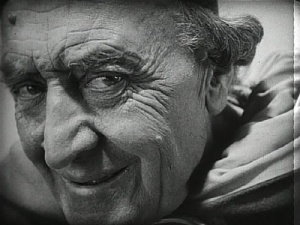1/1/15
La Passion de Jeanne d’Arc or “The Passion of Joan of Arc” (1928) Director: Carl Theodor Dreyer

★★★★★
The Passion of Joan of Arc is a deep, impassioned character study and is based on the surviving record of the trial of Joan of Arc (1412-1431) from when she was captured by the English and burned at the stake during the 100 Years War. Her mythic life is highly celebrated worldwide and has become an integral legend to French national identity. The film details the final hours of Joan’s life and compresses the 29 sessions of Joan’s trial into a single day as she is examined by a cohort of judges, tormented and tortured by guards, and ultimately publicly burned at the stake in Rouens.
The Passion of Joan of Arc is a towering achievement that is without equal in the history of cinema. Falconetti delivers one of the all-time greatest performances and the highly experimental cinematography is shot and edited to perfection.
In 1925, the French production company Societe Generale de Films invited the Danish director Carl Theodor Dreyer to make a movie after experiencing a string of recent successes. Ideas for themes included Marie Antoinette or the Medicis, but they settled on Joan of Arc who had been sainted only six years earlier. The pre-production for the film lasted over a year as Dreyer conducted exhaustive research on medieval life and hired Pierre Champion as his historical consultant because he had recently published an updated edition of the trial of Joan of Arc.

Renee (Maria) Falconetti was a popular actress on the French stage, but for the part of Joan, along with all other characters in the film, the actors were asked not to wear any makeup. This was made possible thanks to a new kind of film developed –panchromatic black and white film stock that broader light spectrum sensitivity. Dreyer was unusual in that he demanded complete silence on the set, an unusual request for a silent film. He also often took many different shots of the same scene, sometimes as many as forty, he would playback the poor scenes with the actors until they found the perfect pose he demanded. Falconetti pleaded that her head not be shaved at the end of the film, but Dreyer required absolute authenticity. As an actress she had mainly performed in comedy shows before Dreyer found her, and she struggled with mental illness all her life folllowing this film. During the scene in which they bloodlet Joan’s arm, real blood from a real puncture was filmed, though it was actually a stand-ins arm for Falconetti as the entirety of the film was shot in chronological order.

The production designers Hermann Warm (a designer of the sets for The Cabinet of Dr. Caligari) and Jean Hugo constructed an entire medieval village for the set, one of the most expensive sets at the time in Europe. However not all of the massive set is visible in the movie as the cinematography is one of the most daring achievements of the silent era with rapid montages inspired by Eisenstein’s Battleship Potemkin, intimate closeups and obscure camera angles which create a unique connection between audience and subject. In an Aristotelian manner (see Poetics), the audience is brought down to Joan, the object of pity, while she is always looking upward at the magistrates and judges. There is a clear hierarchical recognition of the tragic hero and her villainous interlocutors, despite the disorienting spatial recognition the audience often feels.
At the time of its release, The Passion of Joan of Arc was a commercial failure as it was marketed as an art film and the general public preferred more exciting talkies, rather than slow-paced emotional silent melodramas. Critics, however, lauded the film, particularly in the United States. For a long time, the film was thought to be lost after the original negative was destroyed in a fire at UFA Studios in Berlin in 1928 and a shattered Dreyer was forced to edit a second version using his many other shots for a second-rate edition. However the following year, this edited nitrate version was lost in a fire, as well, and was thought to be totally lost until in 1951 a film historian recovered a copy of the second-rate edition that had a baroque musical score dubbed over it. Miraculously, an original Danish print was discovered in 1981 in a janitor’s closet at a Norwegian mental institution.
As an actress, Falconetti lived a life of frivolity off-screen. She only ever acted in two films, The Passion of Joan of Arc being her final performance. She quickly fell into debt and eventually lived a distant life, increasingly involved in strange mysticism in Buenos Aires, and she struggled to make a living after the death of her French benefactor. She died under mysterious circumstances which many sources claim was suicide in 1946. She was only 35 when playing the role of the Maid of Orleans, Joan of Arc.
While a difficult film to score, the best version is Richard Einhorn’s acclaimed 1994 Voices of Light whose bell sounds were actually recorded in the church of Domremy where Joan was born.

Click here to return to my film reviews.
Credits:
- Directed by: Carl Theodor Dreyer
- Written by: Joseph Delteil, Carl Theodor Dreyer
- Starring:
- Renée Jeanne Falconetti…..Joan of Arc (Jeanne d’Arc)
- Eugène Silvain…..Évêque Pierre Cauchon
- André Berley…..Jean d’Estivet, the prosecutor
- Maurice Schutz…..Nicolas Loyseleur, a canon
- Cinematography: Rudolph Maté
- Edited by: Marguerite Beaugé, Carl Theodor Dreyer
- Music by: Léo Pouget, Victor Alix
- Distributed by: Société Générale des Films

LikeLike
Pingback: #10 The Passion of Joan of Arc – 1000 Films Blog